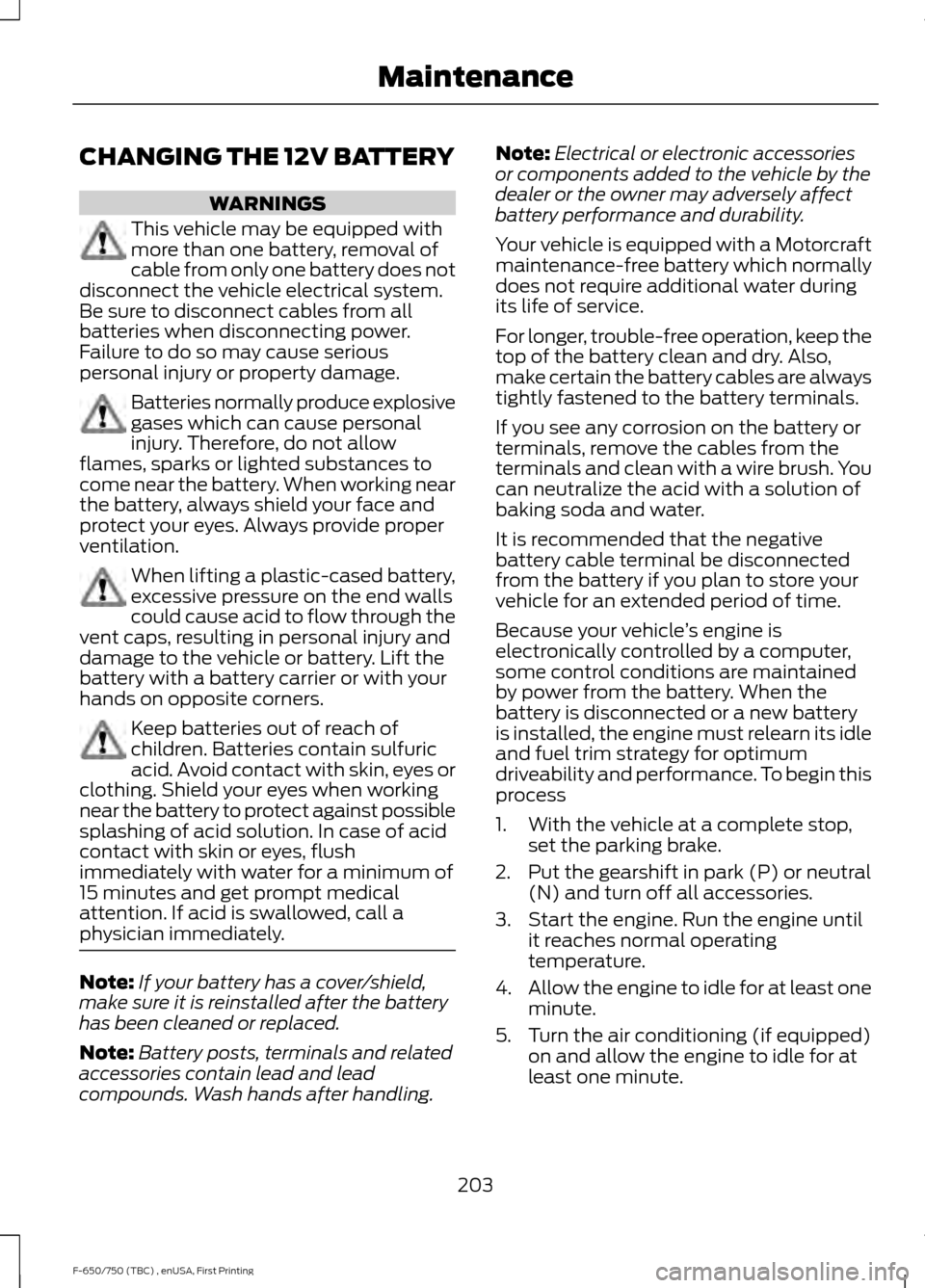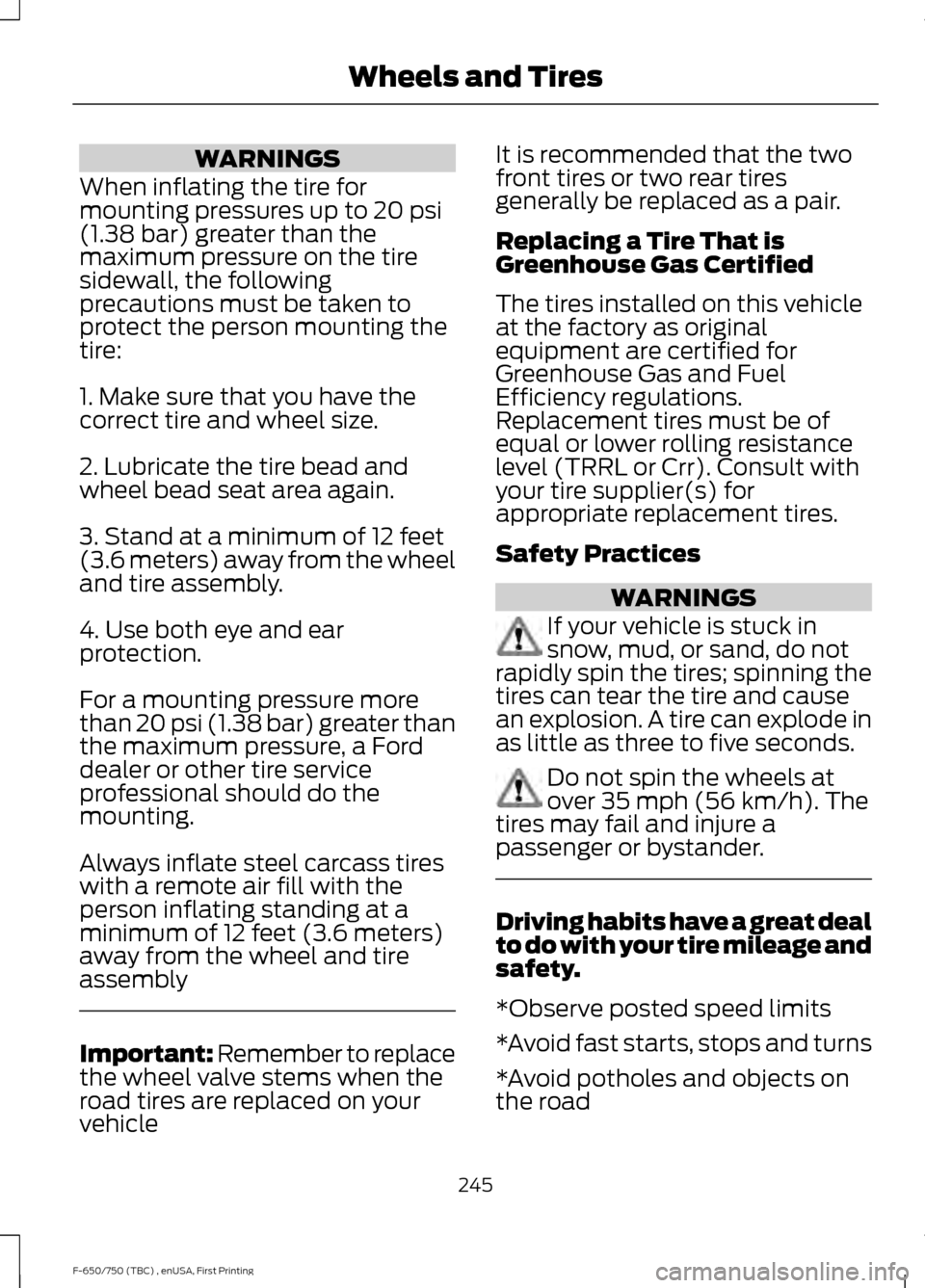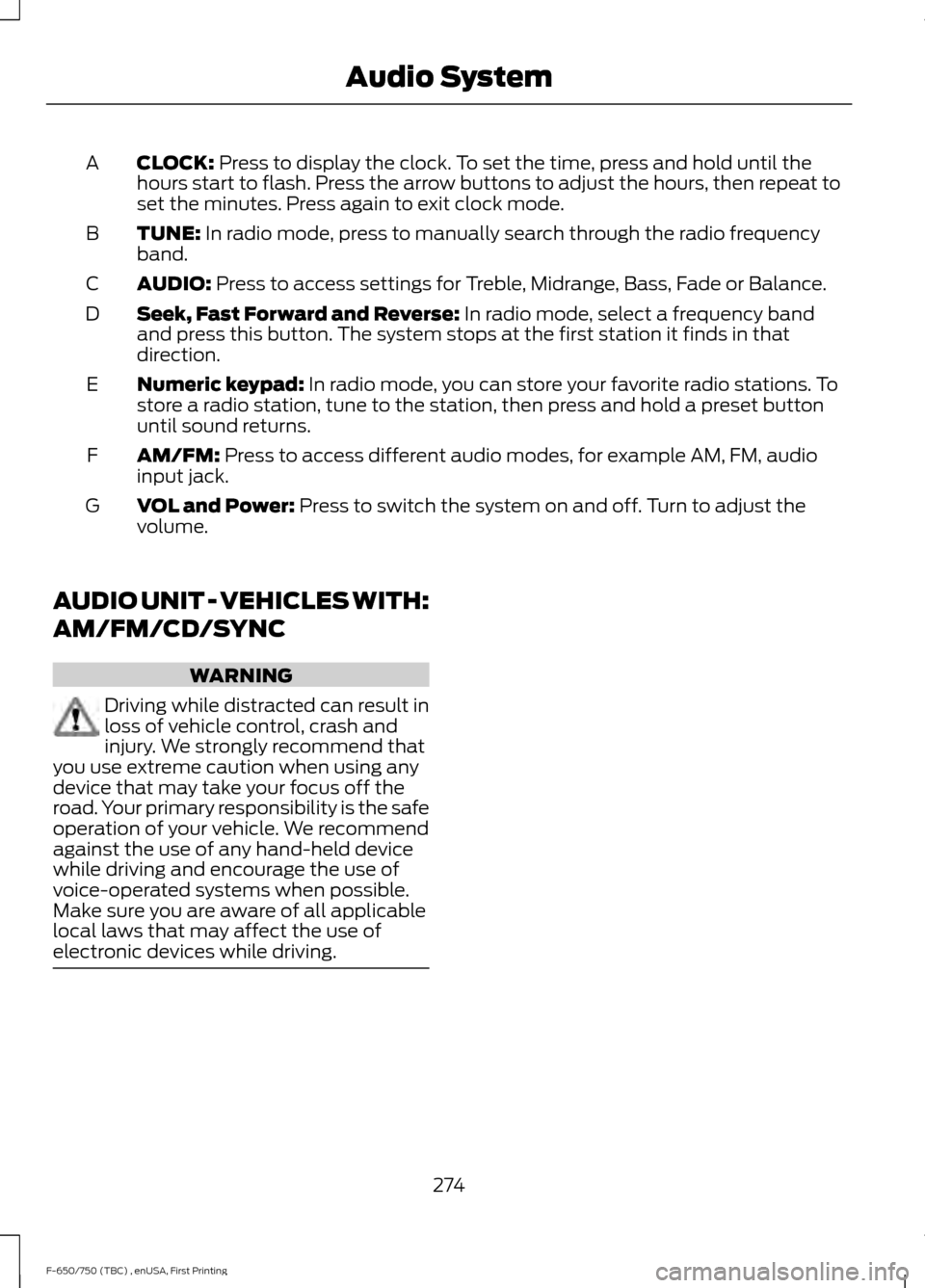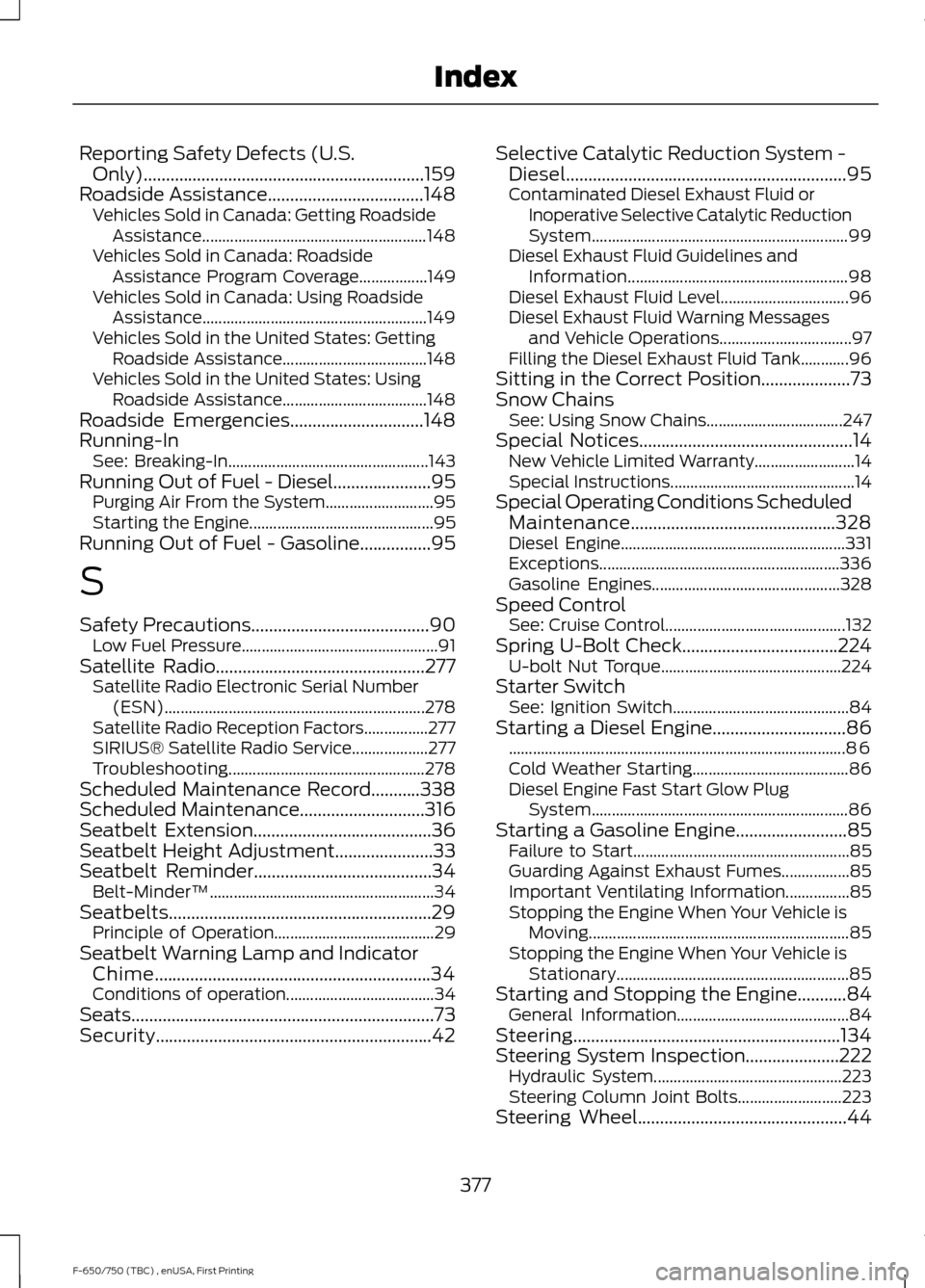stop start FORD F750 2017 13.G Owner's Guide
[x] Cancel search | Manufacturer: FORD, Model Year: 2017, Model line: F750, Model: FORD F750 2017 13.GPages: 382, PDF Size: 5.18 MB
Page 206 of 382

CHANGING THE 12V BATTERY
WARNINGS
This vehicle may be equipped with
more than one battery, removal of
cable from only one battery does not
disconnect the vehicle electrical system.
Be sure to disconnect cables from all
batteries when disconnecting power.
Failure to do so may cause serious
personal injury or property damage. Batteries normally produce explosive
gases which can cause personal
injury. Therefore, do not allow
flames, sparks or lighted substances to
come near the battery. When working near
the battery, always shield your face and
protect your eyes. Always provide proper
ventilation. When lifting a plastic-cased battery,
excessive pressure on the end walls
could cause acid to flow through the
vent caps, resulting in personal injury and
damage to the vehicle or battery. Lift the
battery with a battery carrier or with your
hands on opposite corners. Keep batteries out of reach of
children. Batteries contain sulfuric
acid. Avoid contact with skin, eyes or
clothing. Shield your eyes when working
near the battery to protect against possible
splashing of acid solution. In case of acid
contact with skin or eyes, flush
immediately with water for a minimum of
15 minutes and get prompt medical
attention. If acid is swallowed, call a
physician immediately. Note:
If your battery has a cover/shield,
make sure it is reinstalled after the battery
has been cleaned or replaced.
Note: Battery posts, terminals and related
accessories contain lead and lead
compounds. Wash hands after handling. Note:
Electrical or electronic accessories
or components added to the vehicle by the
dealer or the owner may adversely affect
battery performance and durability.
Your vehicle is equipped with a Motorcraft
maintenance-free battery which normally
does not require additional water during
its life of service.
For longer, trouble-free operation, keep the
top of the battery clean and dry. Also,
make certain the battery cables are always
tightly fastened to the battery terminals.
If you see any corrosion on the battery or
terminals, remove the cables from the
terminals and clean with a wire brush. You
can neutralize the acid with a solution of
baking soda and water.
It is recommended that the negative
battery cable terminal be disconnected
from the battery if you plan to store your
vehicle for an extended period of time.
Because your vehicle ’s engine is
electronically controlled by a computer,
some control conditions are maintained
by power from the battery. When the
battery is disconnected or a new battery
is installed, the engine must relearn its idle
and fuel trim strategy for optimum
driveability and performance. To begin this
process
1. With the vehicle at a complete stop, set the parking brake.
2. Put the gearshift in park (P) or neutral (N) and turn off all accessories.
3. Start the engine. Run the engine until it reaches normal operating
temperature.
4. Allow the engine to idle for at least one
minute.
5. Turn the air conditioning (if equipped) on and allow the engine to idle for at
least one minute.
203
F-650/750 (TBC) , enUSA, First Printing Maintenance
Page 248 of 382

WARNINGS
When inflating the tire for
mounting pressures up to 20 psi
(1.38 bar) greater than the
maximum pressure on the tire
sidewall, the following
precautions must be taken to
protect the person mounting the
tire:
1. Make sure that you have the
correct tire and wheel size.
2. Lubricate the tire bead and
wheel bead seat area again.
3. Stand at a minimum of 12 feet
(3.6 meters) away from the wheel
and tire assembly.
4. Use both eye and ear
protection.
For a mounting pressure more
than 20 psi (1.38 bar) greater than
the maximum pressure, a Ford
dealer or other tire service
professional should do the
mounting.
Always inflate steel carcass tires
with a remote air fill with the
person inflating standing at a
minimum of 12 feet (3.6 meters)
away from the wheel and tire
assembly Important: Remember to replace
the wheel valve stems when the
road tires are replaced on your
vehicle It is recommended that the two
front tires or two rear tires
generally be replaced as a pair.
Replacing a Tire That is
Greenhouse Gas Certified
The tires installed on this vehicle
at the factory as original
equipment are certified for
Greenhouse Gas and Fuel
Efficiency regulations.
Replacement tires must be of
equal or lower rolling resistance
level (TRRL or Crr). Consult with
your tire supplier(s) for
appropriate replacement tires.
Safety Practices
WARNINGS
If your vehicle is stuck in
snow, mud, or sand, do not
rapidly spin the tires; spinning the
tires can tear the tire and cause
an explosion. A tire can explode in
as little as three to five seconds. Do not spin the wheels at
over 35 mph (56 km/h). The
tires may fail and injure a
passenger or bystander. Driving habits have a great deal
to do with your tire mileage and
safety.
*Observe posted speed limits
*Avoid fast starts, stops and turns
*Avoid potholes and objects on
the road
245
F-650/750 (TBC) , enUSA, First Printing Wheels and Tires
Page 277 of 382

CLOCK: Press to display the clock. To set the time, press and hold until the
hours start to flash. Press the arrow buttons to adjust the hours, then repeat to
set the minutes. Press again to exit clock mode.
A
TUNE:
In radio mode, press to manually search through the radio frequency
band.
B
AUDIO:
Press to access settings for Treble, Midrange, Bass, Fade or Balance.
C
Seek, Fast Forward and Reverse:
In radio mode, select a frequency band
and press this button. The system stops at the first station it finds in that
direction.
D
Numeric keypad:
In radio mode, you can store your favorite radio stations. To
store a radio station, tune to the station, then press and hold a preset button
until sound returns.
E
AM/FM:
Press to access different audio modes, for example AM, FM, audio
input jack.
F
VOL and Power:
Press to switch the system on and off. Turn to adjust the
volume.
G
AUDIO UNIT - VEHICLES WITH:
AM/FM/CD/SYNC WARNING
Driving while distracted can result in
loss of vehicle control, crash and
injury. We strongly recommend that
you use extreme caution when using any
device that may take your focus off the
road. Your primary responsibility is the safe
operation of your vehicle. We recommend
against the use of any hand-held device
while driving and encourage the use of
voice-operated systems when possible.
Make sure you are aware of all applicable
local laws that may affect the use of
electronic devices while driving. 274
F-650/750 (TBC) , enUSA, First Printing Audio System
Page 380 of 382

Reporting Safety Defects (U.S.
Only)...............................................................159
Roadside Assistance...................................148
Vehicles Sold in Canada: Getting Roadside
Assistance........................................................ 148
Vehicles Sold in Canada: Roadside Assistance Program Coverage.................149
Vehicles Sold in Canada: Using Roadside Assistance........................................................ 149
Vehicles Sold in the United States: Getting Roadside Assistance.................................... 148
Vehicles Sold in the United States: Using Roadside Assistance.................................... 148
Roadside Emergencies
..............................148
Running-In See: Breaking-In.................................................. 143
Running Out of Fuel - Diesel......................95 Purging Air From the System........................... 95
Starting the Engine.............................................. 95
Running Out of Fuel - Gasoline................95
S
Safety Precautions
........................................90
Low Fuel Pressure................................................. 91
Satellite Radio
...............................................277
Satellite Radio Electronic Serial Number
(ESN)................................................................. 278
Satellite Radio Reception Factors................277
SIRIUS® Satellite Radio Service................... 277
Troubleshooting................................................. 278
Scheduled Maintenance Record
...........338
Scheduled Maintenance............................316
Seatbelt Extension........................................36
Seatbelt Height Adjustment
......................33
Seatbelt Reminder........................................34
Belt-Minder™........................................................ 34
Seatbelts...........................................................29 Principle of Operation........................................ 29
Seatbelt Warning Lamp and Indicator Chime..............................................................34
Conditions of operation..................................... 34
Seats....................................................................73
Security..............................................................42 Selective Catalytic Reduction System -
Diesel...............................................................95
Contaminated Diesel Exhaust Fluid or Inoperative Selective Catalytic Reduction
System................................................................ 99
Diesel Exhaust Fluid Guidelines and Information....................................................... 98
Diesel Exhaust Fluid Level................................ 96
Diesel Exhaust Fluid Warning Messages and Vehicle Operations................................. 97
Filling the Diesel Exhaust Fluid Tank............96
Sitting in the Correct Position....................73
Snow Chains See: Using Snow Chains.................................. 247
Special Notices
................................................14
New Vehicle Limited Warranty......................... 14
Special Instructions.............................................. 14
Special Operating Conditions Scheduled Maintenance..............................................328
Diesel Engine........................................................ 331
Exceptions............................................................ 336
Gasoline Engines............................................... 328
Speed Control See: Cruise Control............................................. 132
Spring U-Bolt Check
...................................224
U-bolt Nut Torque............................................. 224
Starter Switch See: Ignition Switch............................................ 84
Starting a Diesel Engine..............................86 ........................................................................\
............ 86
Cold Weather Starting....................................... 86
Diesel Engine Fast Start Glow Plug System................................................................ 86
Starting a Gasoline Engine.........................85 Failure to Start...................................................... 85
Guarding Against Exhaust Fumes.................85
Important Ventilating Information................85
Stopping the Engine When Your Vehicle is Moving................................................................. 85
Stopping the Engine When Your Vehicle is Stationary.......................................................... 85
Starting and Stopping the Engine...........84 General Information........................................... 84
Steering............................................................134
Steering System Inspection
.....................222
Hydraulic System............................................... 223
Steering Column Joint Bolts.......................... 223
Steering Wheel
...............................................44
377
F-650/750 (TBC) , enUSA, First Printing Index